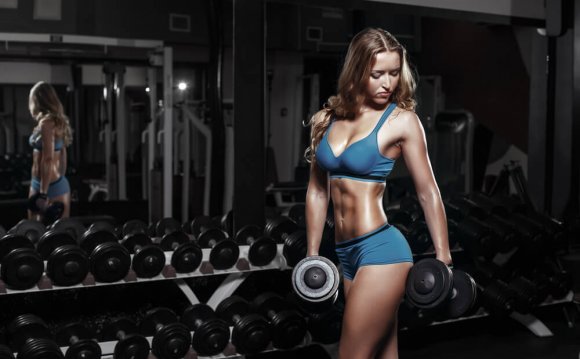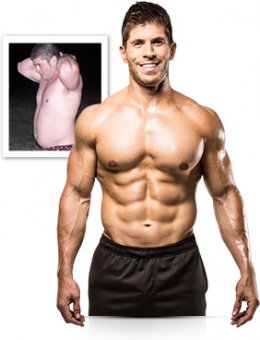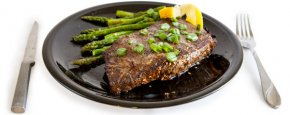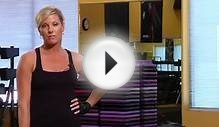
 There are several mysteries of the universe that continue to baffle us: the infinite nature of time and space, the popularity of Justin Bieber, and—more relevant to readers like you—whether it's possible to build muscle and lose body fat at the same time.
There are several mysteries of the universe that continue to baffle us: the infinite nature of time and space, the popularity of Justin Bieber, and—more relevant to readers like you—whether it's possible to build muscle and lose body fat at the same time.
When it comes to getting in shape, most people opt for choosing a singular goal: Either they go on the see-food diet (that is, see it and eat it) for mass gaining, or a calorie-restricted plan that saps their strength, size, and energy in an effort to lose fat.
"I think it's inaccurate to say that it's impossible to build muscle and lose body fat at the same time, which is, in my opinion, a true transformation, " says Stephen Adele, fitness coach, best-selling author, and owner of Colorado-based iSatori, a maker of nutritional products. "I've coached hundreds and thousands of people over the years and I've seen it firsthand—individuals who can gain muscle mass and lose body fat at the same time.
"It presents unique challenges, but it mainly comes down to your approach. I've come to realize there are five rules that I have lived and coached people by on how to transform—encompassing eating, supplementation, training, and mindset—that allow individuals to undergo a transformation in which they can accomplish both goals."
It's truly hard work, but Adele maps out a plan that's worked for thousands of people.
1 Cycle Carbs While Remaining Nitrogen-Positive
Gaining muscle requires a calorie surplus, while cutting fat requires a caloric deficit, so the plan here is to cycle each phase short-term. That's achieved mainly by cycling carbohydrate intake. "I'm a big proponent of carb cycling because it allows your body to burn body fat and build muscle at the same time, " says Adele, who has decades of experience taking individuals through transformation programs aimed at reducing body fat while simultaneously increasing muscle size.
Adele recommends you first determine how many calories your body needs each day. This can be estimated with a calculator or by multiplying your bodyweight x 15. Using this formula, a 200-pound lifter would require 3, 000 calories daily.
 From there, Adele recommends you get 40 percent of your calories from protein, 40 percent from carbs, and 20 percent from fats (40/40/20). Hence, the 200-pound individual would consume 1, 200 calories from protein (300 grams), 1, 200 calories from carbs (300 grams), and 600 calories from fats (67 grams).
From there, Adele recommends you get 40 percent of your calories from protein, 40 percent from carbs, and 20 percent from fats (40/40/20). Hence, the 200-pound individual would consume 1, 200 calories from protein (300 grams), 1, 200 calories from carbs (300 grams), and 600 calories from fats (67 grams).
The carbohydrate rotation comes into play like this (shown over 10 days) for a 200-pound lifter:
Carbohydrate Rotation |
|||
| Day | Percent Carbs | Grams/Carbs | Calories/Day |
| Day 1 | 100% | 300g | 3, 000 |
| Day 2 | 75% | 225g | 2, 700 |
| Day 3 | 50% | 150g | 2, 500 |
| Day 4 | 25% | 75g | 2, 250 |
| Day 5 | |||
| Day 6 | |||
| Day 7 | 2, 750 | ||
| Day 8 | |||
| Day 9 |  3, 000 3, 000 |
||
| Day 10 | |||
Remember, protein and fats don't cycle, so they remain consistent over the course of the entire program: 300 grams of protein and 67 grams of dietary fat per day, which is usually naturally occuring.
With carbs and calories cycling down and then up, your body enters short-term periods of caloric deficit in which body-fat stores can be tapped for energy, and higher-carb and higher-calorie periods in which the body's energy stores are restocked and muscle-building is emphasized.
What's important to remember, says Adele, is that you always remain in a state of positive nitrogen balance, meaning your protein intake is stable and high throughout: "You're taking your body through calorie-positive and calorie-negative phases, but not long enough for it to become catabolic, " which would initiate the burning of lean muscle mass for energy.
He warns against staying on a low-carb diet for too long, saying it compromises the body's ability to build and maintain lean body mass. "You just can't do it sufficiently without adequate carbohydrates, " Adele says.
Adele doesn't recommend anything beyond your standard bodybuilding fare: lean protein sources, complex and starchy carbs over simple sugars (except post-workout), and healthy fats in addition to the saturated ones you naturally consume when eating animal protein. He also realizes that not everyone's going to count calories, but you'll want to learn how to eyeball foods—especially what 35-40 grams of protein looks like—and read labels. What you really need to keep your eye on, he insists, is carbohydrate intake.
Remember, protein and fats don't cycle, so they remain consistent over the course of the entire program.
For many of us, dieting means cravings. "I'm not a big believer in just giving up on certain kinds of foods, " he says. "You have to be creative and not totally give up on something, but rather find ways to satisfy your sweet tooth, which for most people is the hardest part of dieting. Maybe you can turn your BCAA drink into popsicles; we also have a chocolate-flavored Eat-Smart MRP that tastes like a Jell-O pudding dessert."
2 TRAIN ANTAGONIST MUSCLE GROUPS WHILE INCLUDING
ACTIVE REST + HIIT CARDIO
"When you're on a calorie-restricted diet (as part of this program is), it can be easy to start losing your strength along the way, and when you start losing your strength, you can start losing potential muscle mass, " says Adele. "There's some research to support the idea that a muscle is stronger when its antagonist is immediately contracted beforehand, which is the basis of this training program."
 Doing opposing muscle groups—think biceps/triceps, quads/hamstrings, chest/back—back-to-back is called supersetting. You rest only after you've completed a movement for each body part.
Doing opposing muscle groups—think biceps/triceps, quads/hamstrings, chest/back—back-to-back is called supersetting. You rest only after you've completed a movement for each body part.
Supersets are intense, but Adele has upped the intensity even more. By engaging in active rest—not to be confused with sitting on a bench and texting between sets—you follow your superset with 30-60 seconds of work, whether it's jumping rope, box squats, step-ups, or any activity that keeps your body moving. Only after this bout of active rest can you take a minute of full rest.
"[The active rest] doesn't have to be extremely intense by any means; it's just to get your heart rate up, the intensity of the workouts maximized, and should be done at a comfortable pace, " Adele says. "After completing all three exercises, rest for a minute and repeat the cycle for the prescribed number of sets. So you get strength, volume training, and cardio work done over the course of your workout.
"The idea here is that active rest during weight training can deplete most—if not all—of your glycogen (stored form of carbohydrate) levels in the body. So when you do your cardio session after your workout, you've completely depleted almost all of your glycogen and are now burning mostly body fat."
The training split Adele prescribes follows a two-on/one-off approach, so you'll be in the weight room two out of every three days. But you'll be doing high-intensity interval training (HIIT) 6-7 days a week to help strip off fat.
The week breaks down like this:
Training Split |
||
| Workout + Active Rest | HIIT Cardio | |
| Back/Chest | 20-40 min | |
| Shoulders/Traps/Abs | ||
| Biceps/Triceps | ||
| Quads/Hamstrings/Calves | ||
| Cycle repeats | ||
INTERESTING VIDEO












